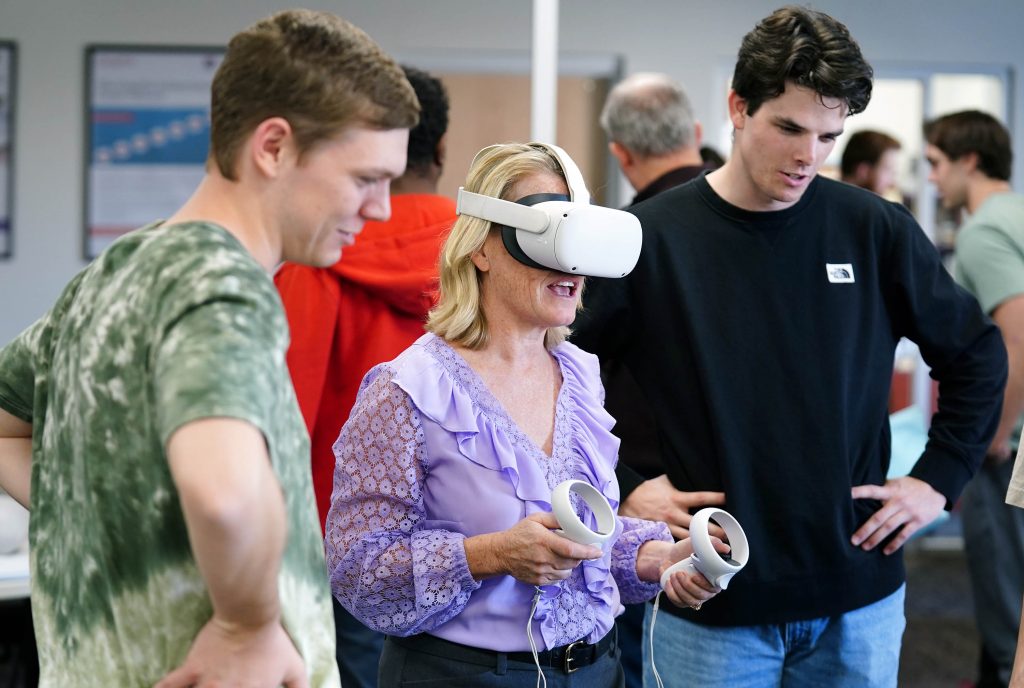
Photos by Ralph Freso
The creaky, wooden pirate ship jibes and pitches as the swish of the water and slap of the waves snap and dissipate in the sea air.
“Oh, wow. This is so realistic,” said Associate Dean of Technology Dr. Pam Rowland, donning virtual reality glasses in the “Buoyant Pirate Kings” adventure, just one of the end-of-semester projects Grand Canyon University computer science students created for Dr. Isac Artzi’s CST 320 Human-Computer Interaction and Communication course.
Teams presented the projects to faculty, fellow students and campus leaders Thursday in the Cyber Center of Excellence.
Immersed in the program long enough, you might get a little seasick.
“OK. Are we about to be boarded?” asks Artzi, grasping two controllers while wearing a bulky, spacey VR headset, his head tilted toward the ceiling and looking as if he’s swatting at flies. He’s immersed in the VR seafaring pirate world, which isn’t so much a video-game-type pirate adventure ‑ though it has that fun feel to it ‑ as it is an educational experience.
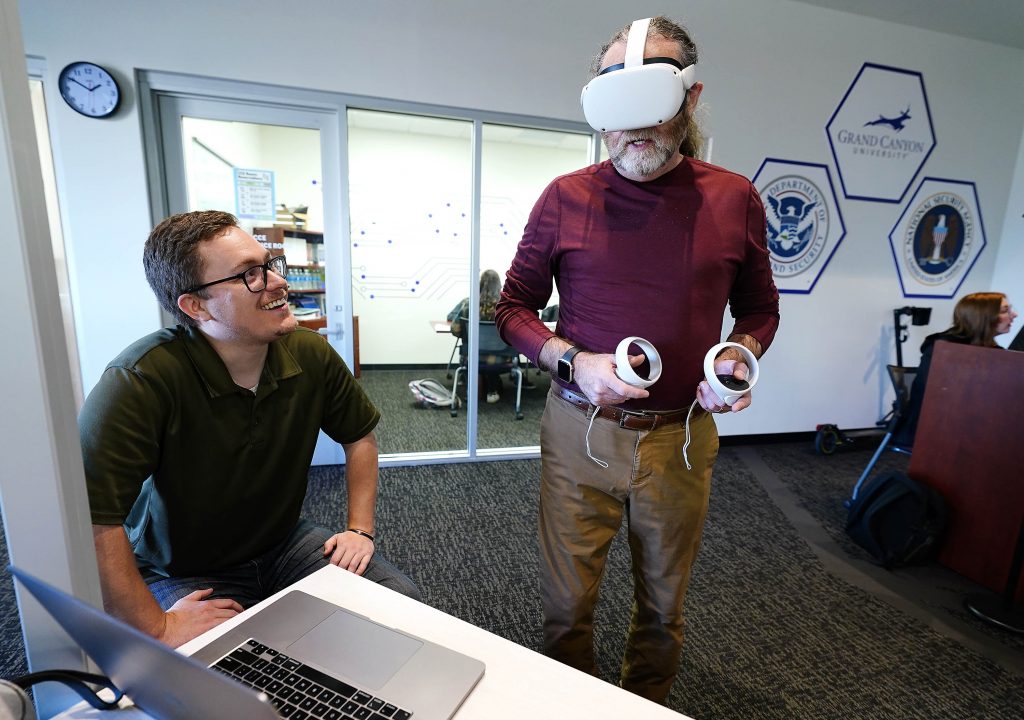
Ricardo Escarcega, a junior with a big data analytics emphasis, sets the scene: You’re getting chased by the Pirate King and you must answer a set of physics questions correctly. If you get an answer wrong, the Pirate King shoots a cannon at you. Answer enough wrong and you’ll sink.
“That is exactly what I want people to experience ‑ how easy it is to fool the human mind into thinking they’re actually floating on water and getting dizzy from floating,” Artzi conveys to the group as he’s still wearing the goggles.
He wants these projects to engross players and whisk them away to a different world, so much so that they forget they’re in a GCU classroom.
In a project set on the sea, that means simulating movement so you cause a little seasickness. In this case, seasickness means good results.
Although Artzi can’t see their reaction to his comments, Escarcega’s team, which also includes junior game development and simulation students Dylan Johnson and Adonijah Farmer, pumps their fists and lets out a silent cheer.
“He (Artzi) wanted the project to have you immersed into a scenario where you hear the birds. You hear the waves. You hear everything and you actually feel like you’re rocking with the boat ... It’s using most of the senses that you have,” Escarcega said.
But also, the team hit the mark by fulfilling the purpose of the project: to teach physics in VR.
Students in the class had to pick one of three concepts – equilibrium, buoyancy or pulleys – and were given freedom from there to create anything they wanted to teach those concepts.
“I gave them a very simple task. … Re-imagine how we can teach physics in any of the topics in VR with some constraints,” Artzi said. “It has to be an educational experience.”
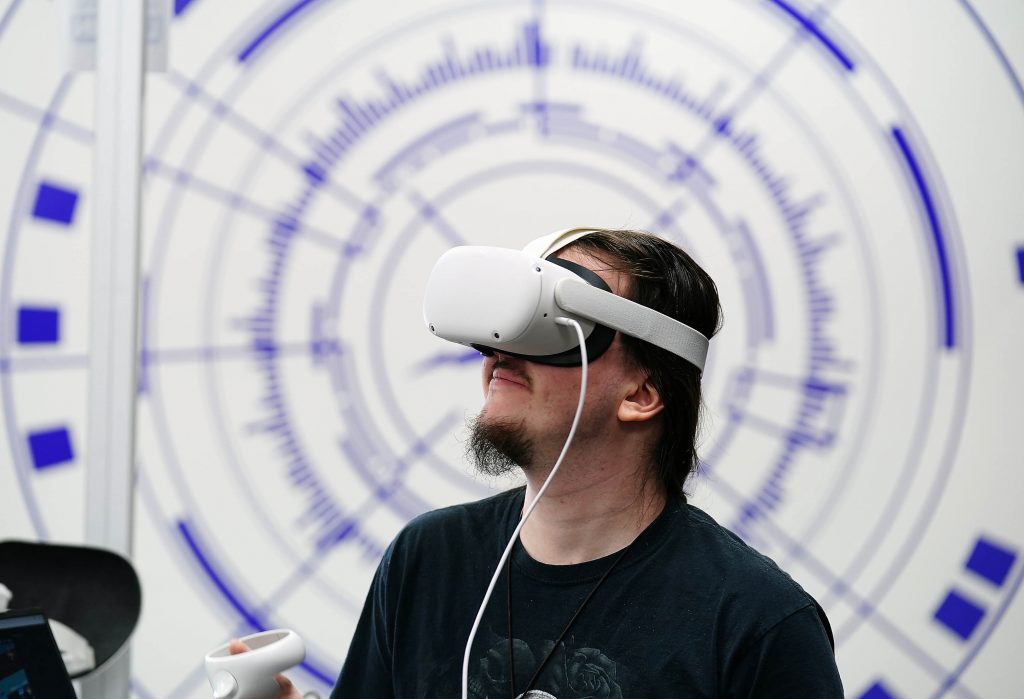
That means including teaching components, such as presentation, practice and assessment.
“We are not replacing the actual physics labs,” Artzi emphasized. “When students prepare for a lab, instead of just learning from a textbook, they can prepare with VR. Then when they’re ready to write the lab report, they can go back to the simulation in VR and reinforce the concepts they learned.”
The benefits of a virtual reality lesson is it can be replayed and reset until the student learns the concept. Plus, there are no lab safety issues to deal with.
Students used Oculus Quest 2 VR headsets, the Unity 3D game engine and artificial intelligence via OpenAI to create their projects.
Many of them include an AI chatbox feature for interactive learning, a “guide on the side,” so to speak, that’s available 24 hours a day seven days a week, unlike in a limited-hours physics lab.
“So you can be as interactive as you want,” said Artzi.
Escarcega, Johnson and Farmer chose to teach buoyancy in their pirate game. One scene explains buoyancy, the next is the game experience and a third scene gives you feedback on what concepts you might need to review.
One of the questions you might be asked: “What is the principle that describes why ships float?”
Answer: Archimedes’ principle.
Jack Utzerath and Hunter Jenkins, juniors studying big data analytics, conceived a virtual reality gym for their project to teach users about how pulley systems work.
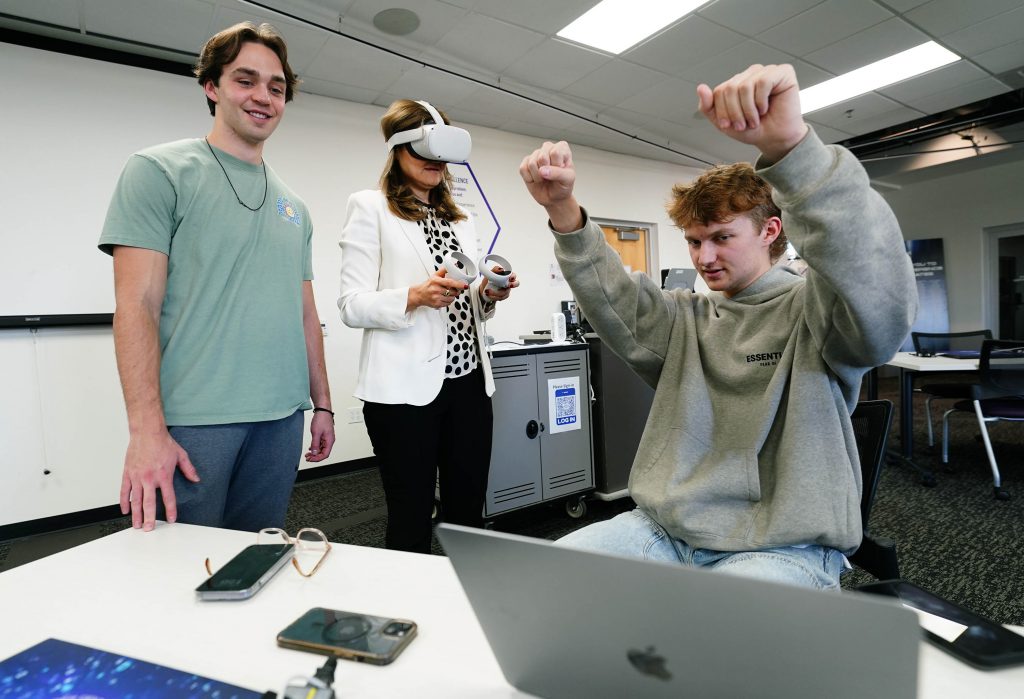
“We both go to the gym. There are a lot of pulley systems in the gym so we’re like, why don’t we just teach about pulley systems within the context of a gym?” said Utzerath.
The program teaches beginners about the four machines they’ll be using: a cable lat pulldown, tricep pushdown, bicep curl and rowing machines.
The project includes an AI personal trainer that guides users through the experience and answers questions about things like using correct form and about the pulley systems.
“It’s kind of personal to us, too. We developed the project so we could teach people who are less confident or who have never experienced a gym yet and teach them about the gym so they can be more confident to go,” Utzerath said.
The project taught Jenkins and Utzerath a few lessons, too, like how ChatGPT can help them in developing their computer science projects.
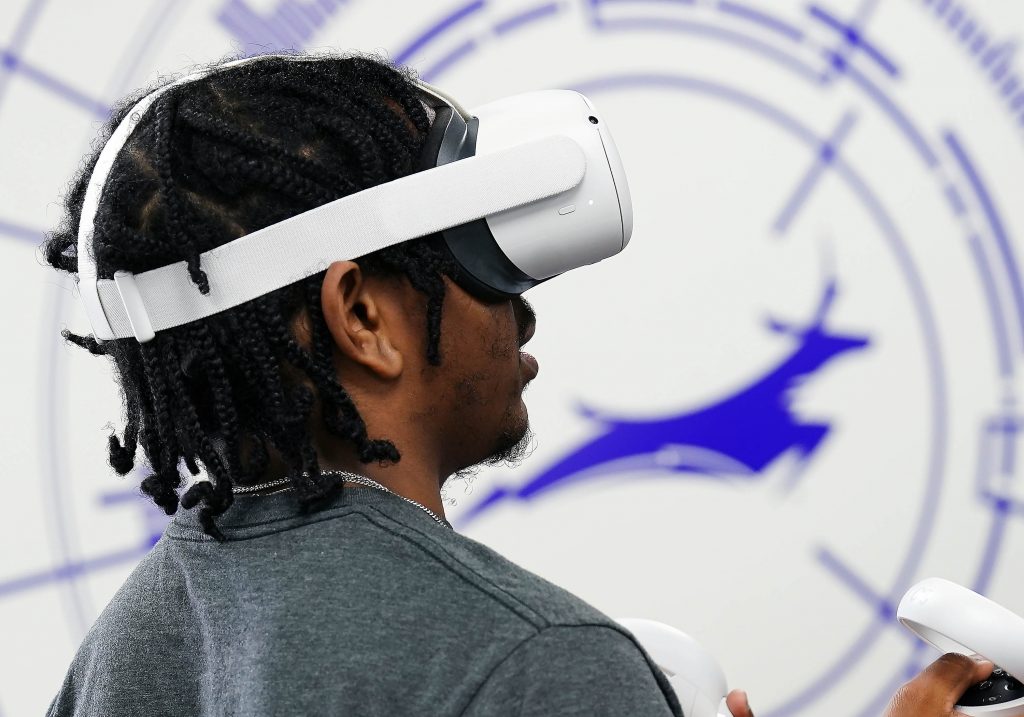
Playing in the sandbox meant something altogether different to Carlos Llanes’ team, which created a buoyancy simulator.
The game-design junior said his team followed a project-based learning curriculum in which they present the objective of what users will be learning before they’re whisked away virtually to a sandbox. It’s where they get to manipulate different properties of objects, experiment on their own and take a quiz afterward to evaluate and reinforce what they learned.
The hardest part of the project was working in Unity, said Llanes.
“When you make one change, the simulation would break and you would have to spend hours and hours, trial and error, basically, to fix it,” he said.
Since everything in the program is related, making one change meant everything changed, so it was difficult to find the problem.
But overcoming those challenges meant they were learning.
“I think you learn a whole lot more when you just jump in and try to make something instead of just being told something,” added big data analytics teammate Owen Kroeger, a junior.
“What’s really interesting was that we didn’t know anything about Unity, and three months later, we built this. So this is pretty cool,” said big data analytics senior John Haviland.
What Escarcega learned the most in doing the “Buoyant Pirate Kings” project, he said, is how “We can go from knowing nothing at all – I didn’t know anything about Unity/VR, nothing – to actually have something we can deploy and can actually teach somebody.”
But beyond those technological concepts, he also learned educational concepts, too.
“We wanted it to be fun,” he said. “… Learning can get boring if you’re not having fun.”
Manager of Internal Communications Lana Sweeten-Shults can be reached at [email protected] or 602-639-7901.
***
Related content:
GCU News: Showcase orbits around virtual reality projects
GCU News: Technology a hit at end-of-program event




